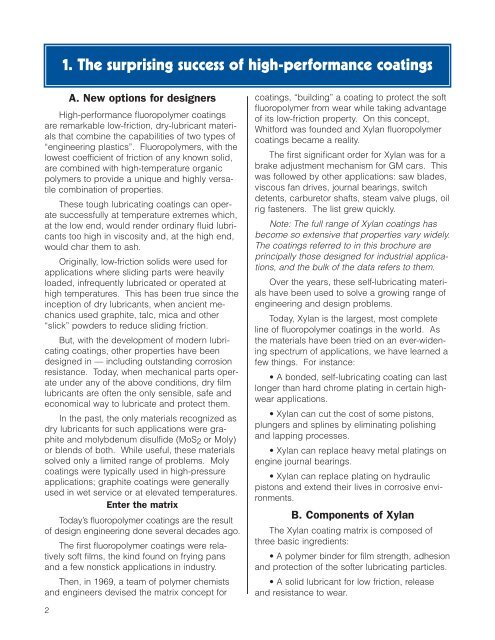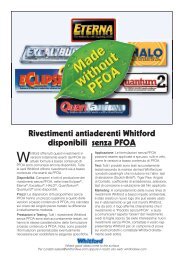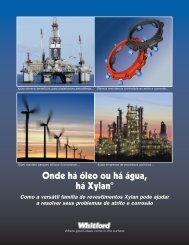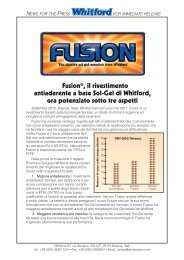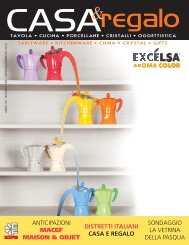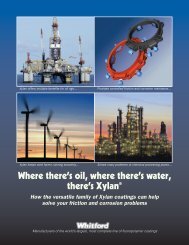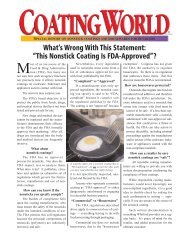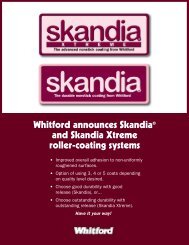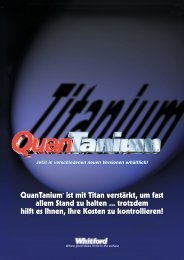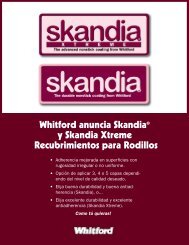Literature PDF
Literature PDF
Literature PDF
- No tags were found...
You also want an ePaper? Increase the reach of your titles
YUMPU automatically turns print PDFs into web optimized ePapers that Google loves.
1. The surprising success of high-performance coatingsA. New options for designersHigh-performance fluoropolymer coatingsare remarkable low-friction, dry-lubricant materialsthat combine the capabilities of two types of“engineering plastics”. Fluoropolymers, with thelowest coefficient of friction of any known solid,are combined with high-temperature organicpolymers to provide a unique and highly versatilecombination of properties.These tough lubricating coatings can operatesuccessfully at temperature extremes which,at the low end, would render ordinary fluid lubricantstoo high in viscosity and, at the high end,would char them to ash.Originally, low-friction solids were used forapplications where sliding parts were heavilyloaded, infrequently lubricated or operated athigh temperatures. This has been true since theinception of dry lubricants, when ancient mechanicsused graphite, talc, mica and other“slick” powders to reduce sliding friction.But, with the development of modern lubricatingcoatings, other properties have beendesigned in — including outstanding corrosionresistance. Today, when mechanical parts operateunder any of the above conditions, dry filmlubricants are often the only sensible, safe andeconomical way to lubricate and protect them.In the past, the only materials recognized asdry lubricants for such applications were graphiteand molybdenum disulfide (MoS 2 or Moly)or blends of both. While useful, these materialssolved only a limited range of problems. Molycoatings were typically used in high-pressureapplications; graphite coatings were generallyused in wet service or at elevated temperatures.Enter the matrixToday’s fluoropolymer coatings are the resultof design engineering done several decades ago.The first fluoropolymer coatings were relativelysoft films, the kind found on frying pansand a few nonstick applications in industry.Then, in 1969, a team of polymer chemistsand engineers devised the matrix concept forcoatings, “building” a coating to protect the softfluoropolymer from wear while taking advantageof its low-friction property. On this concept,Whitford was founded and Xylan fluoropolymercoatings became a reality.The first significant order for Xylan was for abrake adjustment mechanism for GM cars. Thiswas followed by other applications: saw blades,viscous fan drives, journal bearings, switchdetents, carburetor shafts, steam valve plugs, oilrig fasteners. The list grew quickly.Note: The full range of Xylan coatings hasbecome so extensive that properties vary widely.The coatings referred to in this brochure areprincipally those designed for industrial applications,and the bulk of the data refers to them.Over the years, these self-lubricating materialshave been used to solve a growing range ofengineering and design problems.Today, Xylan is the largest, most completeline of fluoropolymer coatings in the world. Asthe materials have been tried on an ever-wideningspectrum of applications, we have learned afew things. For instance:• A bonded, self-lubricating coating can lastlonger than hard chrome plating in certain highwearapplications.• Xylan can cut the cost of some pistons,plungers and splines by eliminating polishingand lapping processes.• Xylan can replace heavy metal platings onengine journal bearings.• Xylan can replace plating on hydraulicpistons and extend their lives in corrosive environments.B. Components of XylanThe Xylan coating matrix is composed ofthree basic ingredients:• A polymer binder for film strength, adhesionand protection of the softer lubricating particles.• A solid lubricant for low friction, releaseand resistance to wear.2


